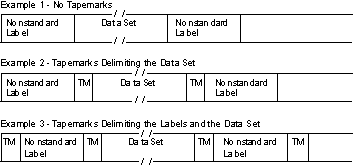 z/OS DFSMS Installation Exits
z/OS DFSMS Installation Exits
 z/OS DFSMS Installation Exits
z/OS DFSMS Installation Exits
|
Previous topic |
Next topic |
Contents |
Contact z/OS |
Library |
PDF
Nonstandard Labels z/OS DFSMS Installation Exits SC23-6850-01 |
|
|
Nonstandard labels do not conform to IBM or ISO/ANSI standard label formats. You can design them and provide routines to write and process them. There are no requirements regarding their length, format, contents, and number, except that the first record on a BCD, EBCDIC, or ASCII tape cannot be a standard volume label. Figure 1 shows some examples of how you can organize tape volumes with nonstandard labels. Other variations are possible. Because your routines do the positioning, there are no special requirements for multivolume or multiple data set organizations. Your routines write all labels and tapemarks. If an operating system access method is used to retrieve the data, tapemarks should precede and follow the data set to indicate the end-of-data-set condition for forward and backward read operations. Nonstandard labeled tapes are not supported in a library (either by the Tape Library Dataserver or by a manual library). Figure 1. Examples
of Tape Organizations with Nonstandard Labels




|
 Copyright IBM Corporation 1990, 2014 Copyright IBM Corporation 1990, 2014 |